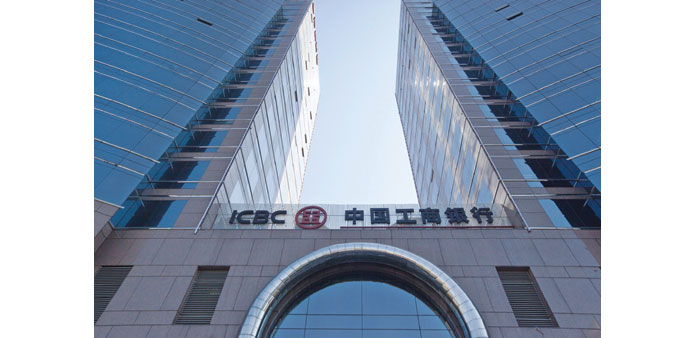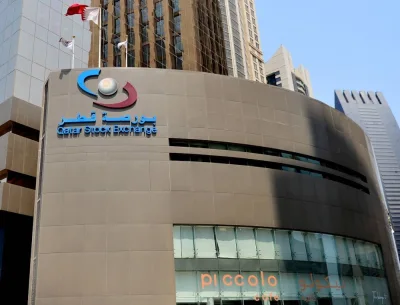Industrial & Commercial Bank of China logo is seen outside a branch in Beijing. ICBC, the world’s largest lender by assets, last month reported a 0.5% increase in quarterly profit from a year earlier as it more than doubled provisions for bad loans.
Bloomberg
Beijing
China’s broadest measure of new credit slumped to the lowest in 15 months in October, adding to evidence six central bank interest-rate cuts in a year have yet to spur a sustained pick up in borrowing.
Aggregate financing fell to 476.7bn yuan ($75bn), according to a report from the People’s Bank of China yesterday. That was lower than all 25 economists’ projections and less than half the median forecast 1.05tn yuan.
The data rounds out a week of mixed readings that have showed falling exports, tame inflation, slowing industrial output, and a rare bright spot in the form of increased retail spending. The readings underscore the government’s challenge to kick start growth in an economy weighed by overcapacity and debt.
“Notwithstanding the PBoC’s efforts, the lending channel is not working in China,” said Hong Kong-based Alicia Garcia Herrero, chief Asia Pacific economist at Natixis. “The reason is simple: too much leverage.”
In speech delivered Monday and circulated by state media today, Premier Li Keqiang indicated the government has room to act given that the fiscal deficit is only 2.3%, adding that the country could lower taxes further. Li said China must find a balance between stabilising growth and following through with structural reform.
China’s outstanding corporate and household borrowing has surged by two-thirds since 2008 to 208% of gross domestic product, producer prices have slumped for 44 consecutive months and the consumer price index began a downward trajectory in the middle of last year.
That threatens a debt-deflation trap if growth and productivity don’t rev up enough.
China’s 10-year sovereign bonds erased losses after the credit report.
The slowing economy and interest rate cuts are hurting bank profits and margins while lending books are starting to show some strain.
Industrial & Commercial Bank of China, the world’s largest lender by assets, last month reported a 0.5% increase in quarterly profit from a year earlier as it more than doubled provisions for bad loans. Its bad-loan ratio stood at 1.44% of total credit, up from 1.4% at the end of June.
The official nonperforming loan ratio for the banking sector is 1.5%, though analysts say the actual number could be much higher. BNP Paribas SA estimates 9% for Chinese banks listed in Hong Kong, while Autonomous Research says the level could be closer to 20%.
“Banks are still unwilling to lend,” said Tao Dong, chief regional economist for Asia excluding Japan at Credit Suisse Group in Hong Kong. “This is quite weak, even stripping out the seasonality.
The rebound in bank lending, boosted by the PBoC’s injection to the policy banks, has been short lived.”
Tao said the central bank may need to inject another round of liquidity to its policy banks, which lend according to government direction, before the end of this year.
For Xu Gao, chief economist at Everbright Securities Co in Beijing, the problem is on the demand side.
“Companies are unwilling to borrow to invest,” he said. “Monetary easing isn’t enough right now. The government needs to use fiscal and other policies to stimulate demand, or it will struggle to stabilise the economy. “China’s government spending surged four times the pace of revenue growth in October, highlighting policy makers’ determination to meet this years’ growth target of about 7%. Fiscal spending jumped 36.1% from a year earlier to 1.35tn yuan, while revenue rose 8.7% to 1.44tn yuan.
Top leaders have signalled that they won’t tolerate a sharp slowdown in coming years either. President Xi Jinpingsaid last week that average annual growth should be no less than 6.5% in the next five years to realize the nation’s goal to double 2010 GDP and per capita income by 2020.
China’s industrial output matched the weakest gain since the global credit crisis last month, while retail sales accelerated, underscoring a shift in the economy toward greater reliance on consumer spending as old growth engines falter.
Meantime, consumer inflation waned in October while factory-gate deflation extended a record streak of negative readings, highlighting room for further monetary easing. A tepid trade report on Sunday suggested the world’s second-biggest economy isn’t likely to get a near-term boost from global demand as overseas shipments dropped 6.9% from a year earlier.
The “big miss for China’s credit growth in October rings alarm bells about the strength of the economy and significantly increases the chances of continued aggressive easing,” Bloomberg Intelligence economist Tom Orlik wrote in a note. “It lends support to the idea that a combination of falling profits, the high cost of servicing existing borrowing and uncertainty about the outlook has significantly reduced firms’ incentives to borrow and invest. That’s similar to the problem that afflicted Japan during its lost decades.”
Larry Hu, head of China economics at Macquarie Securities in Hong Kong, said the loan data may have been distorted by a local government bond swap program that was introduced this year as provincial authorities use proceeds of note sales to pay off debts at banks and shadow bank lenders.
“The economy is stabilizing at the bottom right now, but has shown no signs of rebounding,” Hu said. “Policy easing will continue.”
New yuan loans fell to 513.6bn yuan, about half September’s level, while M2 money supply growth was 13.5% from a year earlier.
“New loans and aggregate financing were quite low, indicating that the manufacturing sector continues to slow down as banks have tightened the credit line over traditional industries,” said Zhou Hao, a senior economist at Commerzbank in Singapore.
As monetary policy easing has had a “limited impact to help revive momentum,” policymakers are using fiscal policy to stimulate demand, he said.



